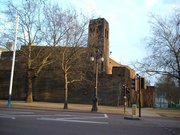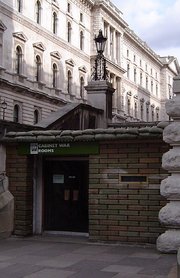Military citadels under London
|
|
A number of military citadels exist under central London, dating mostly from the Second World War and the Cold War. It is already well known that a large network of tunnels exists below London for a variety of communications, civil defence and military purposes (see, for instance, War Plan UK by Duncan Campbell). It is very much less clear how these tunnels, and the various facilities linked to them, fit together. Even the number and nature of these facilities is unclear; only a few have been officially admitted to.
| Contents |
Admiralty Citadel
The Admiralty Citadel, London's most visible military citadel, is located just behind the Admiralty building on Horse Guards Parade. It was constructed in 1940-1941 as a bomb-proof operations centre for the Admiralty, with foundations nine metres deep and a concrete roof six metres thick. Not surprisingly, it was considered virtually bomb-proof.
The building is not very visually appealing - Winston Churchill described it in his memoirs as a "vast monstrosity which weighs upon the Horse Guards Parade" - and ivy has been encouraged to cover it in an apparent attempt to soften its ugliness. Its brutal functionality hid a very practical purpose; in the event of a German invasion, it was intended that the building would become a fortress, with loopholed firing positions provided to fend off attackers.
The Admiralty Citadel is still used today by the Ministry of Defence.
Cabinet War Rooms
The only central London citadel currently open to the public is the Cabinet War Rooms, located in Horse Guards Road in the basement of what is now HM Treasury. This was not a purpose-built citadel but was instead a reinforced adaptation of an existing basement built many years before. The War Rooms were constructed in 1938 and were heavily used by Winston Churchill during World War II. However, the Cabinet War Rooms were vulnerable to a direct hit and were abandoned not long after the war. They were opened to the public in 1984 and are now maintained by the Imperial War Museum.
The section of the War Rooms open to the public is in fact only a portion of a much larger facility. They originally covered three acres (12,000 m²) and housed a staff of up to 528 people, with facilities including a canteen, hospital, shooting range and dormitories. The centrepiece of the War Rooms is the Cabinet Room itself, where Churchill's War Cabinet met. The Map Room is located nearby, from where the course of the war was directed. It is still in much the same condition as when it was abandoned, with the original maps still on the walls and telephones lining the desks. Churchill slept in a small bedroom nearby, with a telephone room next door that provided a direct line to the White House in Washington, DC.
PINDAR
The most important military citadel in central London - and arguably in Britain - is PINDAR, a bunker built beneath the Ministry of Defence on Whitehall. Its construction took ten years, finally coming to a conclusion in 1994 at a reported cost of £126.3 million, but it became operational two years earlier, in 1992. Its high cost became the subject of some controversy in the early 1990s. Much of the cost overrun related to the facility's computer equipment, which proved extremely difficult to install due to the very limited degree of physical access to the site.
PINDAR's main function is to serve as a crisis management and communications centre, principally between the MOD headquarters and the actual centre of military operations, the Permanent Joint Headquarters in Northwood. It is reported to be connected to Downing Street via tunnels under Whitehall. Although it has been rumoured that it connects to some secret underground transport system, this is not the case.
Although PINDAR is very definitely not open to the public, it has had some very limited public exposure. This came in the 2003 BBC documentary on the Iraq conflict, Fighting the War, in which BBC cameras were allowed into the facility to film a small part of a teleconference between ministers and military commanders.
Q-Whitehall
It has been rumoured for many years that a secret communications facility called Q-Whitehall exists under Whitehall. It is claimed to extend as far north as Holborn. Hard evidence for Q-Whitehall remains sketchy; a large covered ventilator shaft on Parliament Square is said by some to be connected to the facility. The journalist Duncan Campbell, who managed to get into a network of communications tunnels below London, has reported that he found a (closed) entrance to Q-Whitehall below Trafalgar Square [1] (http://groups.google.com/groups?selm=memo.19980610022438.51095D%40donc.cix.co.uk&oe=UTF-8&output=gplain). However, the existence of Q-Whitehall does not appear to have ever been officially confirmed or denied and its status remains unclear.


